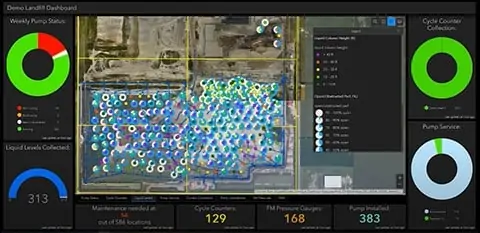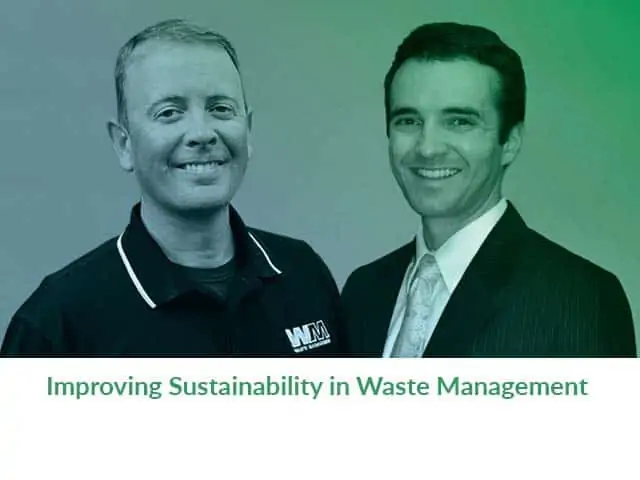

Accumulating liquids are problematic for landfills taking sludges and other wet wastes not traditionally part of the incoming waste stream. Add to the mix increasing precipitation, and operators could be staring down the perfect storm—especially as they work to optimize their gas extraction systems. Here’s the challenge, explains Pete Carrico, SCS Engineers Senior Vice President and national expert on liquids management:
“Trash is porous, and the soils used for daily and intermediate cover usually aren’t, so liquid gets trapped between alternating trash layers as the landfill fills. These “perched” liquids can drain into well columns and block the slotted portion of the extraction well piping that withdraws gas from waste and into the gas collection system.”
Even a robust vacuum on the wells will not pull gas once pipes fill with fluid. With no path to move it from trash into the collection infrastructure, operators work harder to stave off odor and slope stability issues, among potential resulting problems.
The good news is they have a recourse to remove the liquids, unblock well perforations, and extract more gas. They do it by installing dewatering systems: an intricate network of pneumatic pumps, air lines to power them, and conveyance lines, also known as force mains, to remove liquid.
Manufacturers have designed and redesigned their pumps to try and address problems specific to landfill gas extraction systems. And the equipment does the job but requires meticulous attention and skill to keep all the moving parts going. These liquids are rough on pumps due to their harsh nature. The suspended solids and biological material they contain are the biggest challenges, and if the landfill has high temperatures, these liquids can heat up, further taxing the system, Carrico says.
“No pump indefinitely survives the challenging conditions you have in landfills. So, where we can make the biggest difference is with these maintenance programs,” Carrico says. You’re spending O&M budget on what provides the most impact.”
SCS uses dedicated, factory-trained pump crews who focus solely on operating and maintaining gas extraction dewatering systems. These crews help ensure the infrastructure functions as it should, and gas moves through well piping slots, into the gas header piping, and to the blower/flare station for beneficial end-use.
“Operations run more smoothly with these crews in place. An SCS field crew is as unique as each landfill. Our specialists have various skill sets, i.e., gas collection system monitoring, surface emissions monitoring, or pump maintenance expertise. That’s how we produce better outcomes in terms of pump performance. If you effectively maintain and repair the pumps, you will restore them to their designed specifications, pump more liquids, and with greater ease,” Carrico says.
The teams, who work on landfills across the country, stay busy. One site can have five to 300-plus pumps, each with multiple components, and they must be removed and cleaned frequently.
Replacing worn, fouled, or damaged components is an especially tedious and complex job.
Some wells are 70 to 100 feet deep. Pulling air lines, liquid lines, and pumps out from that depth is hard and requires special equipment to do safely. SCS crews know how to take them apart and put them back together; they don’t just lower them back in the ground after working on them. But hook them up to air and water lines and watch them work at capacity before returning them to service.
It’s a value add; with a good maintenance plan and the right crew, pumps can be kept at their designed specifications and run efficiently for many years. They can typically be cleaned and reset for a fraction of their replacement cost.
“We leverage our size and resources. We have a deep bench of in-house experts and engineers willing to share information to help with problems, which is important as conditions vary at each site, as can problems and solutions. So, it’s important not to do this in a silo but rather pull from our broader knowledge base,” Carrico says.
Technology helps too, especially with tracking, maintaining, and reporting progress to clients. A geographical information system (GIS) maps each well’s location, and pump technicians upload data corresponding to each one from wireless tablets almost instantaneously.

The ability to automate tracking and display critical information right away on a dashboard has increased our program’s efficiency. Technicians spend less time tracking and look at analyses of all the landfill conditions to know where to concentrate their efforts, Carrico says.
A few landfills are working to avoid pumping liquids altogether. They are building large gabion rock structures at the landfill’s base, with piping that connects to the extraction well system, creating a conduit. Liquids automatically drain to the bottom where leachate is intended to go while effectively pulling more gas into the gas collection system.
“This is a newer trend that some of our clients are already doing. And we are involved supporting the well designs,” Carrico says.
For now, in most cases, achieving the best outcomes is about investing in pumps and a good maintenance program.
“Monitoring and regularly measuring—checking stroke-counters, which show how many times a pump cycles, and checking flow meters to know how many gallons a day a system produces are key to finding savings. It’s how you reduce or prevent catastrophic failures,” says Greg Hansen, Senior Project Manager with SCS Field Services Operations, Maintenance & Monitoring.
To execute properly, Hansen provides this advice for operators setting up a pump program:
Have pump maintenance areas with water, electricity, disposal means for waste liquids, and storage facilities for spare parts and tools. More specifically:
Operators planning on doing maintenance in-house should train their technicians on cleaning, servicing, and testing pumps. Either SCS or the pump manufacturer can provide this training.
Above all, Hansen says, “You need a comprehensive OM&M program. The better the job tuning pumps, the better they do in the field, and the longer they work before being cleaned or repaired. It’s a continual process.”
More Resources

Dave and Dennis discuss how operational improvements are being made in this essential service and its environmental footprint. They dive into the 24/7 maintenance and monitoring of landfills, adjusting to changing conditions in real-time, reducing cost, generating renewable energy, improving the health and safety of operators, and being proactive in a changing world. We also hear about an Ignition-based solution called Connected Landfills that improves connectivity, mobility, and visualization by using data science to facilitate better decisions.
Apple Podcasts | Spotify | Google Play | PodBean | TuneIn